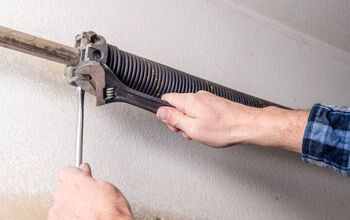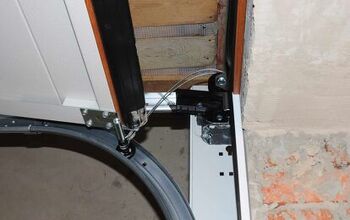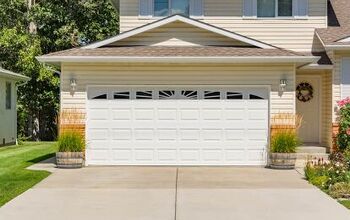Types Of Garage Door Springs

Many homes feature garages, holding everything from cars and trucks to workshops and boxes of unidentified objects. A garage door becomes necessary to keep your garage secure and make it easy for vehicle access. Different types of garage door springs make it possible for your door to open and close smoothly.
Torsion and extension springs are the two main types of springs you’ll find in garage doors. No matter which you use, it’s vital to maintain them well for maximum safety and durability. Extension springs are more affordable at the onset but tend to wear out faster. Tension springs will cost you more upfront but will last longer.
However, the type of garage door spring best for you depends on your situation. No matter what you decide, it’s best to consult a pro if you’re unsure which springs you need. But first, here’s a rundown of your options when it comes to garage door springs.
How Many Types Of Garage Door Springs Are They?
Garage doors primarily use one of two types of springs to function, torsion springs or extension springs. Although both springs serve similar purposes in garage door operation, they work differently. There are also differences in cost and the overall lifespan of each type of garage door spring.
However, whether you use torsion springs or extension springs, you’ll need to ensure they’re well-maintained. Both springs work under a lot of force, and proper care is necessary to maintain safety and avoid damage.
What Is The Difference Between Torsion And Extension Springs?
Torsion and extension springs serve the same purpose but have several differences. The main difference between torsion and extension springs is how they operate. But you’ll also find differences in cost, durability, and installation.
A Closer Look At Garage Door Torsion Springs
Torsion springs work similarly to many types of springs; they use torque. As the garage door opens or closes, it applies force to the springs, causing the springs to rotate.
There are two main categories of torsion springs, standard and torque master. Standard ones work well for lighter garage doors. Torque master springs are the safest option, featuring two springs inside of a shaft.
Torsion springs typically install above the door opening and are horizontal. You’ll usually have one or two torsion springs, depending on the size and weight of the garage door.
An average torsion spring lasts roughly 15,000 cycles (a cycle equaling opening and closing your garage door once). Some can even last up to 20,000 cycles.
Torsion springs cost more upfront than extension springs, roughly $30 to $100 each. Plus, another $75 to $150 per spring for installation. However, they are more durable than extension springs and last longer.
A Closer Look At Garage Door Extension Springs
Extension springs usually install on each side of the garage door in the upper tracks. They extend as the garage door opens, providing a counterbalance to support the door.
The more open the door, the more force on the springs. For safety purposes, each extension spring should also have a safety cable. Therefore, if the spring breaks loose, it won’t fly through the air, causing damage or injury.
There are three main types of extension springs.
- Open-Looped — The most basic type of extension spring and easiest to replace.
- Double-Looped — These are stronger than open-looped, with two coils on the end. They are more difficult to replace than open-looped styles.
- Clip Ends — These extension springs have clips at each end that help reduce the overall stress on the spring. This quality makes these the most durable extension spring but harder to replace.
On average, extension springs cost $15 to $25 each and only about $50 to $100 per spring to replace. An estimated lifespan for extension springs is 10,000 cycles.
What Is The Most Common Garage Door Spring?
Torsion springs are the most common garage door springs. Most likely thanks to their durability and safer features.
What Type Of Garage Door Spring Is Best?
Torsion springs tend to last longer, are more durable, and typically safer than extension springs. However, many new construction homes feature extension springs since they are cheaper upfront. Builders use them to save on overall costs.
Extension springs can still last you for several years, but make sure they have safety cables to limit potential hazards.
How Do I Know What Springs I Need For My Garage Door?
The weight and size of your garage door will be the main factor determining what type of spring you need. Also, if you have little headroom above the garage door, you may need to go with extension springs. There might not be enough room above the door to install torsion springs.
It’s easy to determine what kind of springs you have by looking at the location. If you see horizontal springs above the door, you have torsion springs. If you see springs on either side of the garage door, you have extension springs.
Once you know the types, you need to determine the size you need. For torsion springs, you need to see if it’s a left-hand or right-hand wind. You must also measure the inner diameter, length, and wire diameter.
For extension springs, you need to know the length of your spring and pair it with the weight of your garage door. Various charts and a color-coding system from DASMA (Doors and Access Systems Manufacturers Association) can help determine the spring size you need. When in doubt, consult a professional garage door specialist.
A Recap On Two Types of Garage Door Springs
When it comes to types of garage door springs, you either have torsion springs or extension springs. Torsion springs are typically safer and more durable but cost more upfront. They install above the garage door.
Extension springs are good if you don’t have a lot of headroom since they install on either side of the door. They are also more affordable upfront. However, they don’t last as long as tension springs.
If you need new garage door springs, you’ll need to consider your garage door’s weight and size to determine the best springs for you. Also, think about the space you have for installation and your budget.
If you simply want to replace your current springs, you’ll need to take note of the length and wind direction. If you’re unsure, you don’t want to get the wrong size or type. Therefore, consult a professional to ensure you get precisely what you need.

Stacy Randall is a wife, mother, and freelance writer from NOLA that has always had a love for DIY projects, home organization, and making spaces beautiful. Together with her husband, she has been spending the last several years lovingly renovating her grandparent's former home, making it their own and learning a lot about life along the way.
More by Stacy Randall



























